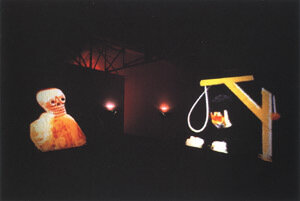Virtual Visions: A Reflection on Susan Hiller's Dream Screens
By Jad Dahshan, third-year student studying Art History and Chemistry
“I'm watching a man who has an amazing psychic power to somehow generate dreams that everyone can see.”
I hear these words in pitch black, then in incendiary red, then in soft lavender. Up past the witching hour, I let myself be enchanted by my computer screen while it flickers from one color to the next as I engage with pioneering conceptual artist Susan Hiller’s 1996 work Dream Screens.
The web-based, interactive artwork begins by asking you to choose a language, after which audio starts playing and you are given the power to click any part of the blank monochrome screen to change its color. The audio playing is a fragmented discussion about modern art, dreams, and color theory, overlaid against a background of electronic beeps signaling the words “I am dreaming” in morse code, heartbeats, the blinks of a pulsar, and other sounds. The narrator’s voice often fades, reemerging with a different topic like the smooth but irrational transitions we encounter in dreams. The experience allows you to explore the ways you react (and don’t react) to different combinations of color, sound, and language.
“It is not a virtual exhibition, but a conceptual one.”
Hiller’s is among several works featured in the Gray Center for Arts and Inquiry’s Another Idea, an actual conceptual art exhibition, which opened on June 1 and will run until July 31. Conceived and organized by Zachary Cahill and Mike Schuh, the online exhibition departs from the technologically mediated and heavily corporatized state of our social relations in quarantine. This is not a show digitized due to lockdown measures. It is not a virtual exhibition, but a conceptual one.
Susan Hiller at Pérez Art Museum Miami. Image courtesy of Contemporary Art Daily.
Housed on the Gray Center’s website, Another Idea borrows from Conceptualist and Fluxus practices and their descendents to highlight the different ways we can understand how art functions in various spatio-temporal and material contexts. The works chosen range from the interactive to the durational and many will grow and evolve over the course of the show. As such, they can be experienced and activated wherever and whenever the viewer is at any given moment: while taking a walk outdoors, at a desk after logging off of work, or in the dark, early hours of the morning, as is the case for this writer.
Hiller has been working with the audio-visual since the 1980’s, exploring our collective experiences of the irrational, the unconscious, and the paranormal in works like Dream Screens, Dream Mapping (1974), and Belshazzar’s Feast (1983-4). Dream Screens simulates the similarly fragmentary and distraction-prone experiences of browsing the overloaded space of the internet and navigating our subconscious in dreams.
A still from Hiller’s Dream Mapping. Image courtesy of the artist’s website.
That said, in my particular context, Hiller’s Dream Screens are replacing the actual dreams I would be having were I in bed like a normal, healthy person. Yet I am dreaming, projecting my mind onto the website I’m browsing instead of the backs of my eyelids. As I listen and click away at my screen, inundated with colors and sounds, I find myself trying to synchronize my clicks with the soundtrack, changing the screen from blood red to a calm lilac with every heartbeat or matching the color to the tone of the narration. As I get distracted again and again, I begin unconsciously drawing invisible lines with my cursor, tracing concentric circles and stars and swirls and whatever other shapes come out naturally. In fact, distraction seems like a foundational part of the experience.
My mind a program reprogrammed by color, I eventually turn from the changing colors on my screen to those of phosphene and closed eyes. I’ll scroll through dream images like an Instagram feed for the night, and then browse through Twitter like a dream sequence when I wake up in the morning.
Hello! I'm Jad and I am a rising fourth-year studying Art History and Chemistry at the College. I write for artmejo.com about global and Arab contemporary art and occasionally do some arts reporting for the Chicago Maroon. At school, you'd usually find me dangling off a rope in Le Vorris & Vox Circus's practice room at the Logan Center or filming an Instagram story at the Smart Museum. Since being quarantined though, I haven't really strayed beyond the edges of my laptop or sketchbook. Each week of “Another Idea,” I will explore and reflect one piece in the exhibition. Experience and explore the exhibition yourself at The Gray Center.




